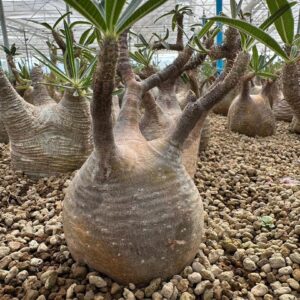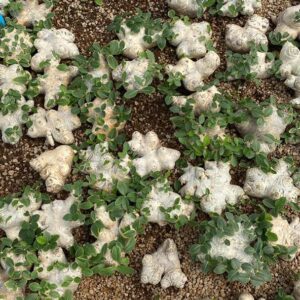Philodendron Billietiae Variegated
The Philodendron Billietiae Variegated is a rare and highly sought-after plant among collectors and houseplant enthusiasts. Known for its striking variegation, elongated leaves, and vibrant orange petioles, this tropical plant is a true gem in the world of aroids. Below is an in-depth exploration of its characteristics, care requirements, and unique appeal.
Overview and Origin
The Philodendron Billietiae Variegated is a sub-variety of Philodendron billietiae, a species native to the tropical rainforests of Brazil, Guyana, and French Guiana. First discovered in 1981 by Frieda Billiet, this plant thrives as a hemi-epiphyte in its natural habitat, often climbing trees to access sunlight. Its variegated form features leaves adorned with creamy white and green patterns, making it one of the most visually captivating members of the Araceae family17.
Physical Characteristics
-
Leaves: The plant’s elongated, strap-shaped leaves are its most distinctive feature. These leaves can reach impressive lengths when grown under optimal conditions and display unique variegation patterns that vary from plant to plant.
-
Petioles: The bright orange petioles add to its ornamental appeal, contrasting beautifully with the foliage.
-
Growth Habit: As a climbing vine, it requires support structures like moss poles or trellises to grow upright. Indoors, it typically reaches about 3 feet in height but can grow taller in outdoor settings.
Care Requirements
Caring for the Philodendron Billietiae Variegated requires attention to detail due to its specific needs:
Light
-
Prefers bright, indirect light. Direct sunlight can scorch its delicate leaves, while low light may reduce variegation intensity.
Soil
-
Thrives in well-draining soil with high organic matter. A mix of peat moss, perlite, and orchid bark works well for this plant.
Watering
-
Requires consistent moisture but should not be overwatered. Allow the top inch of soil to dry out between waterings to prevent root rot.
Humidity
-
High humidity (above 60%) is essential for optimal growth. Using a humidifier or placing the plant near a water source can help maintain the required humidity levels.
Temperature
-
Grows best in temperatures between 65°F and 85°F (18°C–29°C). It is not frost-tolerant and should be kept indoors during colder months if grown in temperate climates.
Fertilization
-
Feed with a balanced liquid fertilizer every 4–6 weeks during the growing season (spring and summer). Avoid over-fertilizing as it may damage the roots.
Propagation
Propagation of this plant can be challenging due to its rarity. The most common method is stem cuttings:
-
Select a healthy stem with at least one node.
-
Place the cutting in water or moist sphagnum moss.
-
Keep it in a warm, humid environment with indirect light.
-
Roots typically develop within 4–6 weeks.
How can I propagate a Philodendron Billietiae plant
Propagating a Philodendron Billietiae can be done using two primary methods: stem cuttings and air layering. Here’s a detailed guide for each method:
1. Propagation via Stem Cuttings
This is the easiest and most common method for propagating Philodendron Billietiae.
Steps:
-
Select a Healthy Stem: Choose a stem with at least one node (the point where leaves or aerial roots grow) and ideally 1–2 leaves.
-
Cut the Stem: Using sterilized scissors or pruning shears, make a clean cut just below the node.
-
Prepare the Cutting:
-
Remove any leaves from the lower part of the cutting to expose the node.
-
You can dip the cut end in rooting hormone to encourage faster root growth (optional).
-
-
Choose a Medium:
-
Water Propagation: Place the cutting in a jar of clean water, ensuring the node is submerged. Change the water every few days to prevent stagnation.
-
Soil Propagation: Plant the cutting in moist sphagnum moss or well-draining potting soil. Keep the soil consistently moist but not soggy.
-
-
Provide Proper Conditions:
-
Place the cutting in bright, indirect light.
-
Maintain high humidity around the cutting by covering it with a plastic bag or placing it in a propagation box.
-
-
Monitor Growth: Roots should start forming within 2–4 weeks. Once roots are about 1–2 inches long, you can transplant the cutting into its permanent pot.
2. Propagation via Air Layering
Air layering is ideal if you want to propagate without removing a part of the plant immediately.
Steps:
-
Identify a Node: Find a healthy section of the stem with a node and aerial roots, if possible.
-
Prepare the Area:
-
Gently scrape or remove a small section of the stem’s outer layer near the node.
-
Wrap this area with moist sphagnum moss.
-
-
Secure the Moss:
-
Cover the moss with plastic wrap to retain moisture, and secure it with ties or tape on both ends.
-
-
Maintain Moisture:
-
Check regularly to ensure the moss remains moist by misting it as needed.
-
-
Wait for Roots to Develop:
-
Roots should appear within 4–6 weeks. Once you see healthy roots through the moss, you can cut below this section and pot it.
-
Tips for Successful Propagation
-
Always use clean tools to avoid introducing diseases.
-
Perform propagation during spring or summer when the plant is actively growing for faster results124.
-
Keep propagated cuttings in warm, humid environments for optimal growth.
Both methods are effective, but stem cuttings are quicker and easier for beginners, while air layering minimizes stress on the mother plant
Common Issues
Despite its beauty, the Philodendron Billietiae Variegated can face several problems:
-
Pest Infestations: Susceptible to spider mites, mealybugs, and scale insects. Regularly inspect the plant and treat infestations with insecticidal soap or neem oil.
-
Leaf Yellowing: Often caused by overwatering or poor drainage.
-
Loss of Variegation: Insufficient light can lead to reduced variegation; ensure adequate lighting conditions.
Why Is It So Rare?
The variegated form of Philodendron Billietiae is considered one of the “holy grails” for collectors due to its rarity and high demand. Each plant exhibits unique variegation patterns, making it highly desirable. Additionally, propagation is slow and labor-intensive, further limiting its availability.
Decorative Appeal
This plant serves as a stunning focal point in any indoor garden. Its bold foliage pairs well with minimalist decor styles or tropical-themed interiors. When placed on a moss pole or allowed to climb, it adds vertical interest to spaces.
Toxicity Warning
Like other Philodendrons, this species contains calcium oxalate crystals that are toxic if ingested by pets or humans. Keep it out of reach from children and animals.
Conclusion
The Philodendron Billietiae Variegated is more than just a houseplant; it’s a statement piece that showcases nature’s artistry. While its care demands precision and dedication, the reward is a thriving plant that captivates with its elegance and rarity. Whether you’re an experienced collector or a passionate beginner looking for something extraordinary, this plant is an investment worth making.






Reviews
There are no reviews yet.